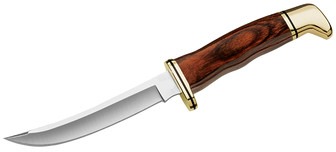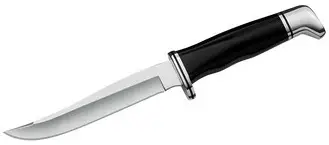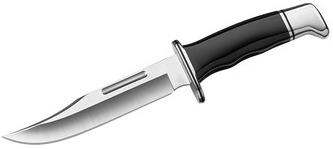|
Buck Classic Fixed Blade Hunting Knives By Gary Zinn  The Buck knives saga is said to have begun in 1902, when Hoyt Buck, a teenaged apprentice blacksmith, learned how to temper steel and make knives. The subsequent history is vague, but apparently knife making was not Hoyt's primary occupation before World War II. However, after the war began he devoted his skills to making combat knives, which he donated to the war effort. These handmade knives won a reputation among the soldiers who used them. After the war, Hoyt and his son, Al, started a custom knife business known as H.H. Buck and Son, in response to a brisk demand for Buck brand knives. After Hoyt died in 1949, Al Buck kept the family business going. The early 1960s marked a pivotal time for the enterprise. It was incorporated as Buck Knives, Inc. in 1961 and shortly thereafter Buck rocked the outdoor knife world by releasing the Model 110 Folding Hunter knife. This revolutionary lock-back folding knife took the market by storm and set off a wave of locking folder knife designs, by various makers, that continues to this day. The success of the Model 110 solidified Buck as a big time player in the outdoor cutlery business, but it is still a family enterprise. Charles Buck, grandson of Hoyt, was the Chairman of the firm until his death in February 2015 and his son, CJ Buck, is President and CEO. Guns and Shooting Online Owner/Managing Editor Chuck Hawks reviewed Buck Knives Famous Model 110 Folding Hunter in 2014, so there is no need for me to say more about it here. Rather, this article is focused on the Buck line of classic, fixed blade hunting knives. This family of hunting knives, six models strong, predates the 1960s. I was unable to determine when the first of these knives was designed and produced in a civilian hunting knife style, but here is what I think: There is a photograph of Hoyt Buck, wearing a blacksmith apron and holding a Pathfinder knife, on the History page of the Buck official website. Since he died in 1949, the design obviously predates that. I am guessing that the Bucks designed the handle style and blade patterns of these knives as they established and grew their post-WW II custom knife business. Perhaps the Pathfinder was the first of the line? Common Features The first common feature of these knives is the handle style. The metal finger guard, subtly finger grooved handle profile and distinctive pommel are common to all the knives in the family. The handles vary slightly in length and girth among the models. Handles are built around a rattail tang, with the pommel cross pinned through the end of the tang. There are two versions of each model. The basic version features an aluminum finger guard and pommel, while these parts are brass in the deluxe version. The handle of the basic version is black phenolic resin, while the deluxe handle is Dymondwood, a resin-infused birch laminate, with a cocobolo stain. The laminate handle material and brass furniture of the deluxe version make it slightly heavier than the basic version of each knife. All models feature 420HC stainless steel blades, the steel used most extensively throughout the entire Buck line. 420HC is known as a good quality knife and impact tool steel. Tough, hard and strong, it has decent edge holding capabilities and is relatively easy to resharpen. The blades are hollow ground and satin finished. Each knife comes with a nicely made leather sheath, which includes a wide handle strap with heavy duty snap to secure the knife. A generously sized belt loop is double riveted to the body of the sheath. Basic model sheaths are black leather and deluxe sheaths are brown. One can look at any two of the six models and immediately know that they are siblings, from the handle style and the hollow ground, satin finished blades. The models vary significantly only in the blade length, pattern, spine thickness and weight. Here is a brief rundown of each model, by blade length. Model 102 Woodsman  The Woodsman has a four inch blade, an OAL of 7-3/4 inches and a spine thickness of 0.120 inches. The blade pattern is a slender clip point with a high hollow grind. The basic version, 102BKS, weighs 2.5 ounces, while the deluxe 102BRS weighs 3.6 ounces. This is a light, nimble and versatile general purpose knife appropriate for everyday field carry. Model 103 Skinner  When someone says "skinner" this is the knife that comes to my mind. The blade has an upswept spine with a short front drop and a cutting edge that curves strongly from a deep belly to a relatively blunt tip. This is an excellent design for skinning any large animal. The blade is four inches long and .0120 inches thick; OAL is 8-1/4 inches. The basic 103BKS weighs 4.3 ounces and the deluxe 103BRS 6.0 ounces. This is the knife in the group with which I have the most hands-on experience. I have never owned one, but my brother-in-law did. He was a livestock farmer in the West Virginia countryside where I grew up. Late autumn was butchering time and each year for over a decade I helped him butcher a dozen or more hogs and steers. I recall one day when he and I together skinned four steers, without having to sharpen the Skinner. Somehow, I became the designated hog skinner and I cannot accurately estimate the number of hog carcass sections I skinned out with that knife. It was so well designed and balanced that it felt like part of my hand. The Buck Skinner also came into play whenever a family member or neighbor got a deer. I have long since left the farming scene and I do not hunt deer much any more, but if I needed a specialized skinner knife this is the one I would get. Model 118 Personal  The Personal has a 4-1/2 inch blade and is 8-1/2 inches long overall; the blade is .0120 inches thick. The basic 118BKS weighs 3.9 ounces and the deluxe 118BRS 5.5 ounces. When I look at a blade pattern, my first thought is, "What would this knife do best?" I tend to think in terms of meat cutting, because of my practical experience in my younger days. To me, the Personal is a slicer, first and foremost. The trailing point blade pattern, with a lot of gentle curve to the edge and a high hollow grind, begs to be used to cut venison steaks and such. There is enough curve in the edge for the blade to be a decent skinner. Plus, the sharp point and moderate blade length imply that the knife can be deftly used for close work, such as caping. I can testify that it also works for filleting fish, but that is another story. In summary, this is a versatile, all around knife. Model 105 Pathfinder  The company history page on the Buck website features a picture of Hoyt Buck holding a Pathfinder. He must have been feeling frisky when he designed it, for the blade profile is unusually complex for a hunting knife. It is slightly serpentine, with a subtle downward curve to the blade spine for most of its length. Then, it curves back up gently to the tip, while the edge curves strongly to join the spine at a medium-sharp swaged point. This is a unique blade form that does not fit any conventional label, such as clip, drop or trailing point. The knife measures 9-1/8 inches OAL, with a five inch long, 0.120-inch thick blade. The 105BKS version weighs 4.5 ounces and the deluxe 105BRS 5.8 ounces. The hollow grind is not quite as high on this blade as on the Woodsman and Personal, so the Pathfinder blade is a bit more robust, although it is the same thickness as the other two. What would this knife do best? It screams "boning knife" to me and, beyond that, the blade is of a size and pattern that make a good all-around hunting and camp knife. I own a deluxe version Pathfinder. It my largest hunting knife and I have not encountered a field or camp cutting task that it was not up to. I say "cutting task," because I refuse to abuse it by using it for chopping or batoning. That is what machetes are for. Model 119 Special and Model 120 General  I am covering these two together because they are the same pattern, but in different blade sizes. The robust clip point General is the Buck rendition of a Bowie knife, which makes the Special a mini Bowie. Both knives have blades 0.175 inches thick. The Special has a six inch blade and is 10-1/2 inches long overall. The basic 119BKS weighs 7.5 ounces and the deluxe 119BRS 10.5 ounces. The General measures 12 inches OAL, with a 7-3/8 inch long blade. The 120BKS version weighs 8.3 ounces and the 120BRS 10.9 ounces. What are these knives good for? Looking badass is the first thing that comes to mind. Seriously, either would be on the mark for any heavy duty knife work that one might need to do. If I were putting together a backcountry excursion/survival kit, I would be very comfortable including one of these knives. I gave my teenaged grandson a deluxe model Special for his birthday a couple of years ago. I know he was impressed, for he acknowledged that it made the cheap "tactical" knives that he had thought were cool look tacky.Made in the USA and backed by Buck Today, not all Buck knives are made in the USA, but these fixed blade hunters are. This assures that they meet the firms highest standards for materials, fit and finish. Just as important, all Buck knives are backed by the their Forever Warranty, which reads as follows, with no convoluted legal jargon involved: We warranty each and every Buck knife to be free of defects in material and workmanship for the life of the knife, and we will repair or replace with a new Buck knife, at our option, any Buck knife that is defective. Buck Knives does not warrant its products against normal wear or misuse. Buck Knives are not intended to be used as hammers, chisels, pry bars or screwdrivers. If your knife was damaged due to misuse, our repair department can analyze the damage and repair it for a reasonable fee. If your knife is unable to be repaired, we will extend a one-time courtesy offer, allowing you the option to purchase a new knife for 50% off of our MSRP price listed on the website, excluding any custom knives or web specials. Moreover, Buck offers repair and sharpening services at very reasonable cost. For instance, if you badly dull a Buck knife and cannot get it sharpened to your satisfaction, send it to the company and they will factory sharpen it for you. The price? Whatever it costs you to ship the knife to Buck, plus $6.95, which includes shipping it back to you. That is a bargain. See the Buck website (www.buckknives.com) for details on sharpening and repair services. MSRP and Retail Prices Without getting into a complete rundown, here is an outline of 2015 MSRPs and discount retail prices of these knives. The lowest MSRP is $73 for the basic Woodsman, while the highest is for the deluxe Special and General, both at $129. MSRP differentials between the basic and deluxe versions of the various models range between $20 and $39. Major internet vendors of Buck knives are generally selling them at about two-thirds of MSRP. Shop around and do the math. Conclusion These knives are not tactical, whatever the heck that means. They do not feature futuristic materials and they do not come in day-glo colors. Rather, they are practical working tools that have passed the test of time. The older I get, the more my interest returns to the things I learned to appreciate in my youth, including these classic Buck hunting knives. |